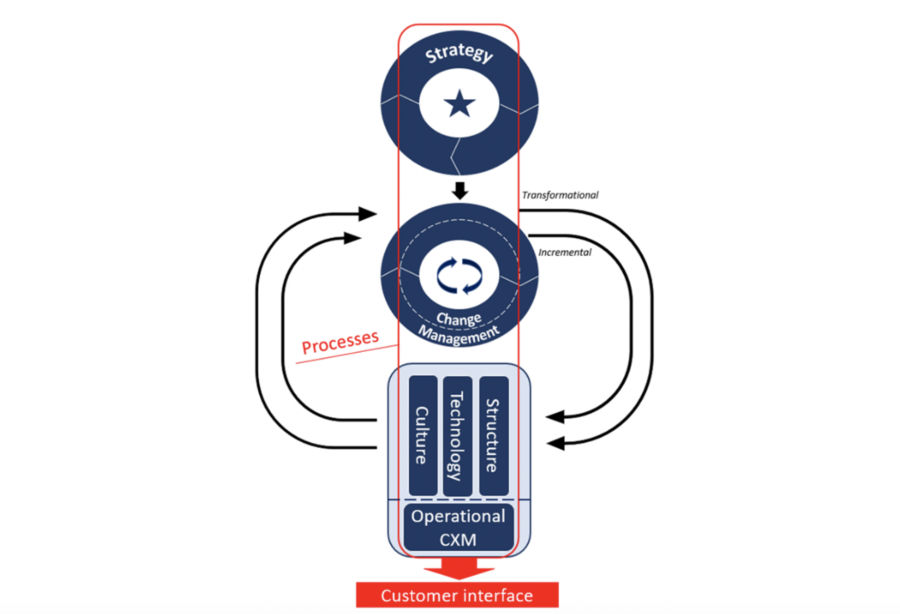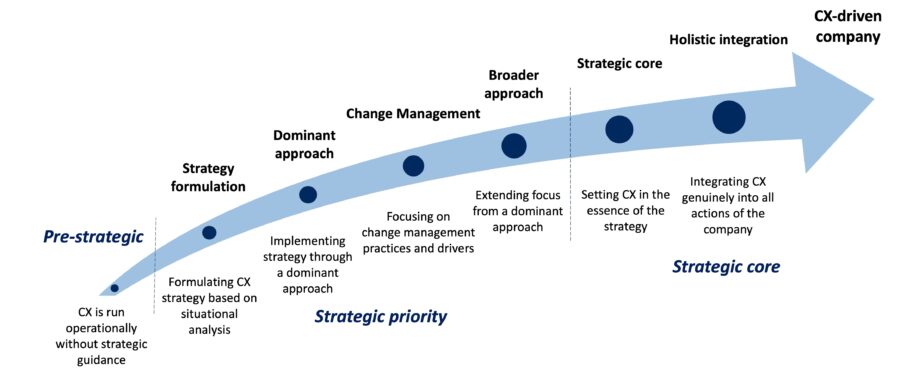
Research Insights – Without integrated strategic approach customer experience won’t create sustainable competitive advantage
Customer experience (CX) has become a critical competitive advantage and differentiator in today’s business. However, companies often fail in their pursuits to create sustainable long-term competitive advantage with CX because strategic approach is neglected, and sufficient change management practices are missing. To address these issues, a research of Strategic Customer Experience Management was conducted. The research covered:
- survey for CX-oriented professionals and practitioners
- extensive literature review of 126 central theoretical sources
- analysis of 46 academic and practical frameworks
- 10 in-depth qualitative interviews in carefully selected large-size companies, most of which are internationally operating companies on the Helsinki Stock Exchange.

Key Findings
The research established a systematic and holistic framework for Strategic Customer Experience Management. The framework consists of seven highly interconnected building blocks. Strategic Customer Experience Management focuses on continuous development of these internal capabilities, which are the source of competitive advantage.
- CX must be managed strategically as an integral part of an overall business strategy. The strategy provides necessary vision, focus, resources and wide-spreading organizational commitment to CX pursuits. Within these constraints change management can effectively drive CX creation and development. Synchronized transformational and incremental change management practices are needed for effective implementation of strategic, tactical and operational initiatives and corrective actions throughout the company. It’s imperative to integrate CX to the overall strategy and its’ implementation to ensure successful change.
- There are fundamental problems in companies to connect their strategic CX pursuits into operational actions. Three primary approaches to bridge the gap between strategy and customer interface were identified. The building blocks of Processes, Technology or Culture works as a power core from which the change is facilitated. Together with favorable organizational structure these building blocks create a supporting organizational context and holistic ecosystem for operational CXM.
- Culture driven companies aim to build CX oriented culture by nurturing desirable cultural characteristics.
- Process driven companies rely on effective and comprehensive CX processes and their integration into the overall process architecture.
- Technology driven companies focus to use data and technology intensively to enable efficient, personalized and data-driven operations in the customer interface.
- Superficial improvements and sub-optimization won’t generate long-lasting impacts, but holistic organizational support is needed. Empowered, knowledgeable and accountable people in all organizational levels create desired CX but the company owns it. CX is attached to processes, functions, structures, policies and culture, which remain, while people may change. An integrated customer-centric organization with aligned building blocks is needed for setting change drivers and removing decelerating barriers systematically. All building blocks are essential in this quest. In the end, success is evaluated in the customer interface.
The journey towards sustainable competitive advantage
The main phases of SCXM are pre-strategic, strategic priority and strategic core. Creating sustainable competitive advantage requires setting CX as a strategic priority and proceed in a journey to maintain competitiveness against market forces and rising customer expectations. Initiatives to build up the CX capabilities must be targeted along the journey so that the prerequisites are met, and the building blocks evolved effectively. Through the stages, strategic emphasis rises and the influence spreads towards holistic integration.

CX must be managed strategically to create sustainable competitive advantage. To achieve sufficient power and holistic approach it is inevitable to integrate CX to the overall business strategy, change management practices, culture and other aspects of the company. The SCXM framework is crucial to maintain the overall view and consistently develop CX creation capabilities over a long-term.
Stay connected as I hope to offer you more interesting insights in the future as the field offers a lot of exciting possibilities for further research.
Tags: change, competitive, culture, customer, experience, management, processes, strategy, structure, technology



Comments are closed here.